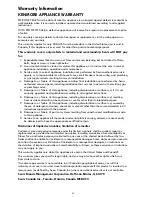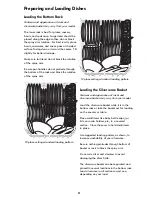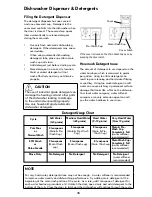
17
17
Solutions to Common Dishwashing Problems
•
Check water hardness. For extremely
hard water, it may be necessary to install
a water softener. (See Detergent Chart).
•
Use Fresh Detergent.
•
Make sure items are not blocking the
spray arms, preventing them from
rotating.
•
Assure that dishware is not extending over
the square area in the middle of the lower
rack and so preventing the arm from
telescoping up to spray into the upper
rack.
Dishes not Dry
•
Select heat dry option.
•
Make sur
e the rinse aid dispenser is fi lled.
•
Increase the discharge setting of rinse aid.
(See Rinse Aid).
•
Check the incoming water temperature.
Be sure it is at least 120
o
F (49
o
C).
•
Check for proper loading-avoid nesting
items.
•
Plastic items may need to be towel dried.
Glassware/Flatware Spotted or Cloudy
•
Check water hardness. For extremely
hard water, it may be necessary to install
a water softener. (See Detergent Chart).
•
Water temperature may be low. Avoid
extremely low or high temperatures. (See
Factors Aff ecting Performance.
•
Avoid overloading and improper loading.
(See Preparing and Loading Dishes).
Dishware Chipped
•
Load with care and do not overload. (See
Preparing and Loading Dishes).
•
Place delicate items in top rack.
•
Place glasses securely against pins and
not over pins.
•
Load items so they are secure and don’t
jar loose when moving racks in and out.
Move racks in and out slowly.
•
Make sure tall glasses and stemware will
clear top of tub when rack is pushed in.
•
Fine antique china and crystal should be
hand-washed.
•
Cups with a concave bottom will collect
water. Load them at the far left and right
of the upper rack so they will be held in a
tilited position.
•
Unload the lower rack fi rst. During
unloading any liquid left in depressed
areas of mugs or other dishware in the
upper rack may fall onto any dishware
left in the lower rack.
Dishware Stained or Discolored
•
Tea and coff ee can stain cups. Remove
the stains by hand washing in a solution
of 1/2 cup (120 ml) bleach and one quart
(1L) of warm water. Rinse thoroughly.
•
Iron deposits in water can cause a yellow
or brown fi lm. A special fi lter installed
in the water supply line will correct this
problem. (See Removing Spots and Film).
•
Aluminum utensils can leave gray/black
marks when they rub against other items.
Load Properly.
•
Certain high acid foods can cause
discoloration of stainless steel and plastics
if allowed to sit for a long period. Use
the Rinse Only cycle or rinse by hand if
not operating dishwasher at once.
•
Use fresh detergent. Old detergent is
ineff ective.
•
Make sure rinse aid dispenser is fi lled.
•
Check to see that the proper amount of
detergent is being used for cycle selected.
(See Detergent Dispenser).
•
Home water pressure may be too low-it
should be 20 to 120 pounds per square
inch (psi).
Etching
•
Using too much detergent especially in
soft or softened water causes damage
that looks like a fi lm but cannot be
removed.
•
Adjust the amount of detergent based
on the water hardness. (Check Detergent
Chart).
•
Use the heat dry option and do not leave
dishware in unit longer than necessary.
Detergent Left in Cups
•
Detergent may be old. Discard and use
fresh detergent.
•
Be sure the dish load doesn’t block spray
from entering the detergent cup.
•
Check to see if cycle has been completed.
•
Make sure items do not prevent the
detergent dispenser from opening.
















































